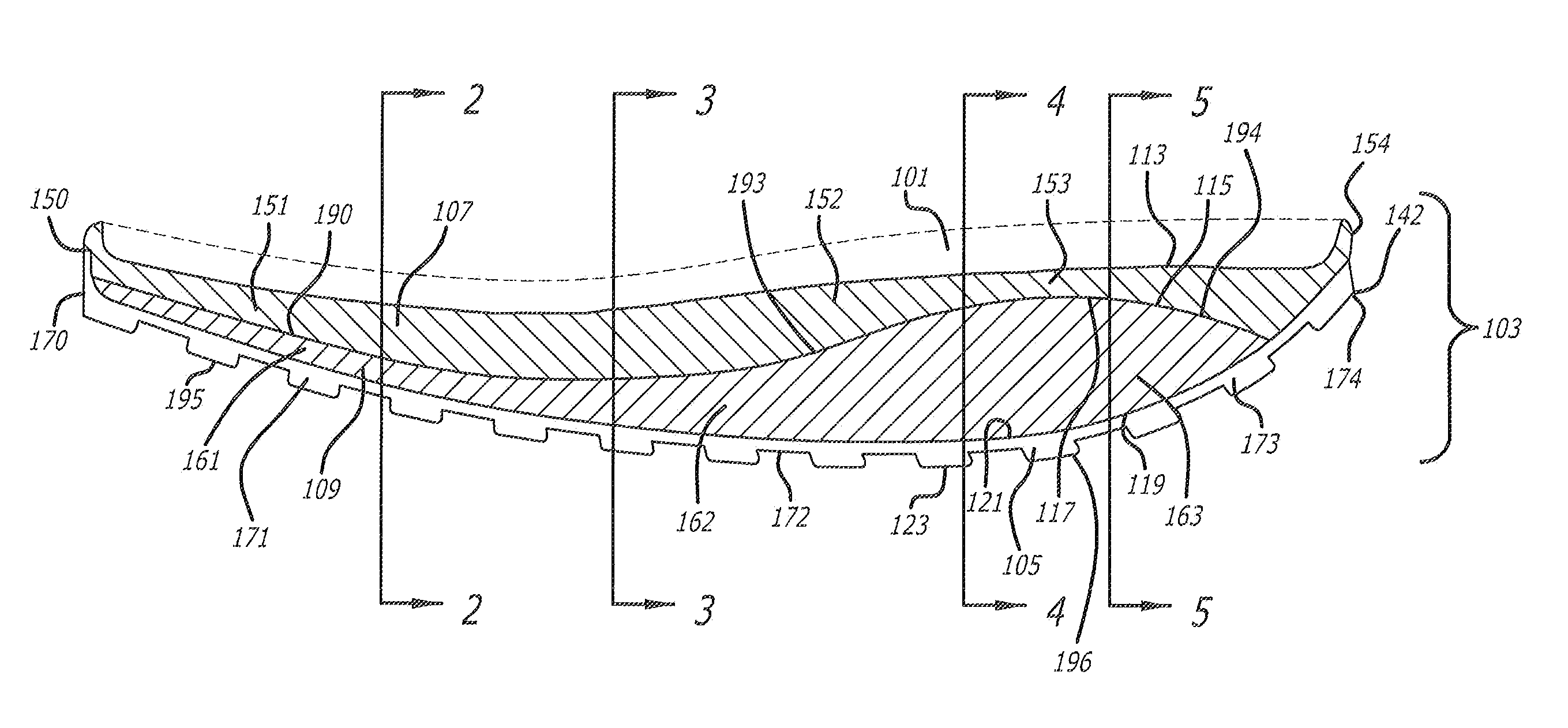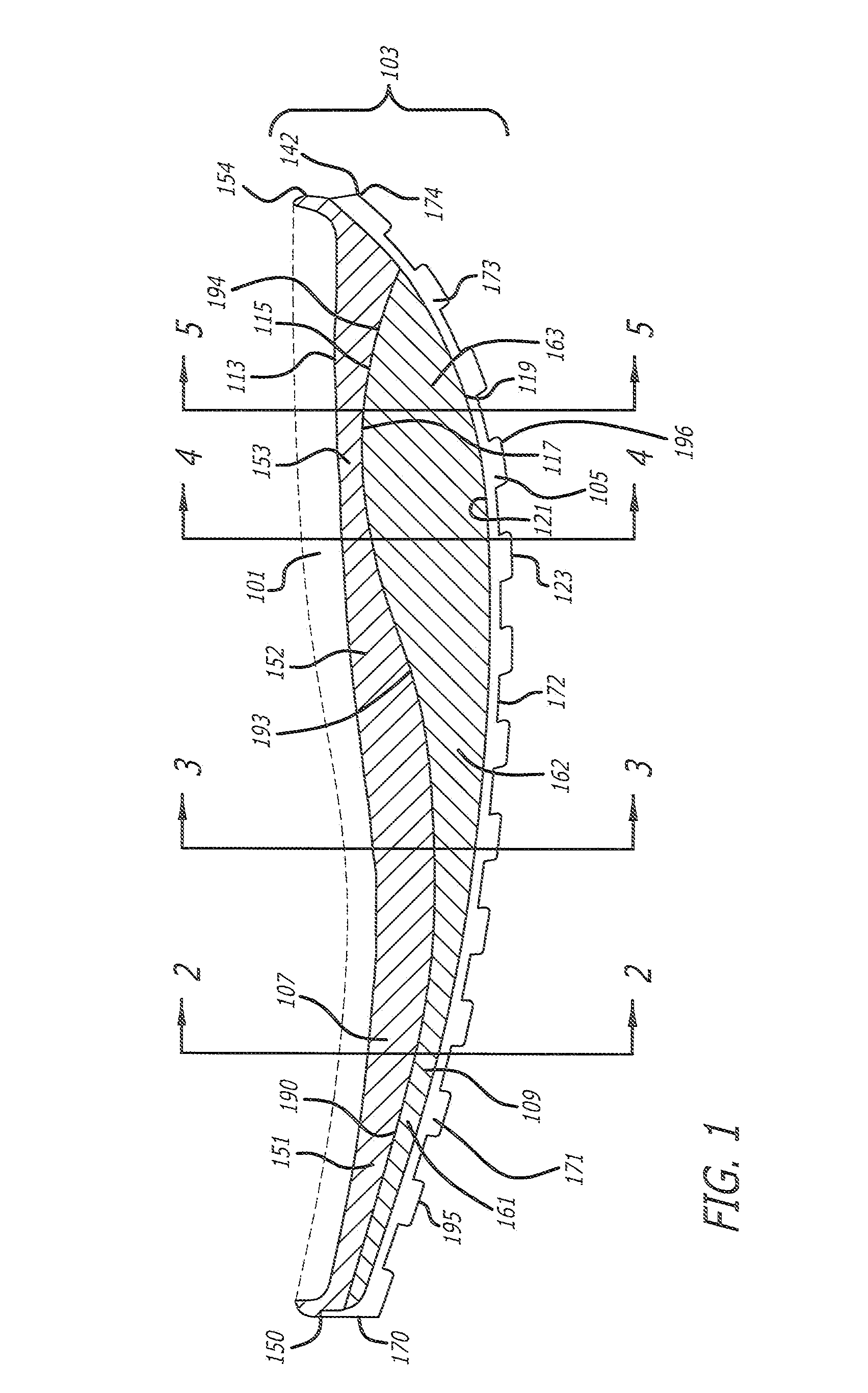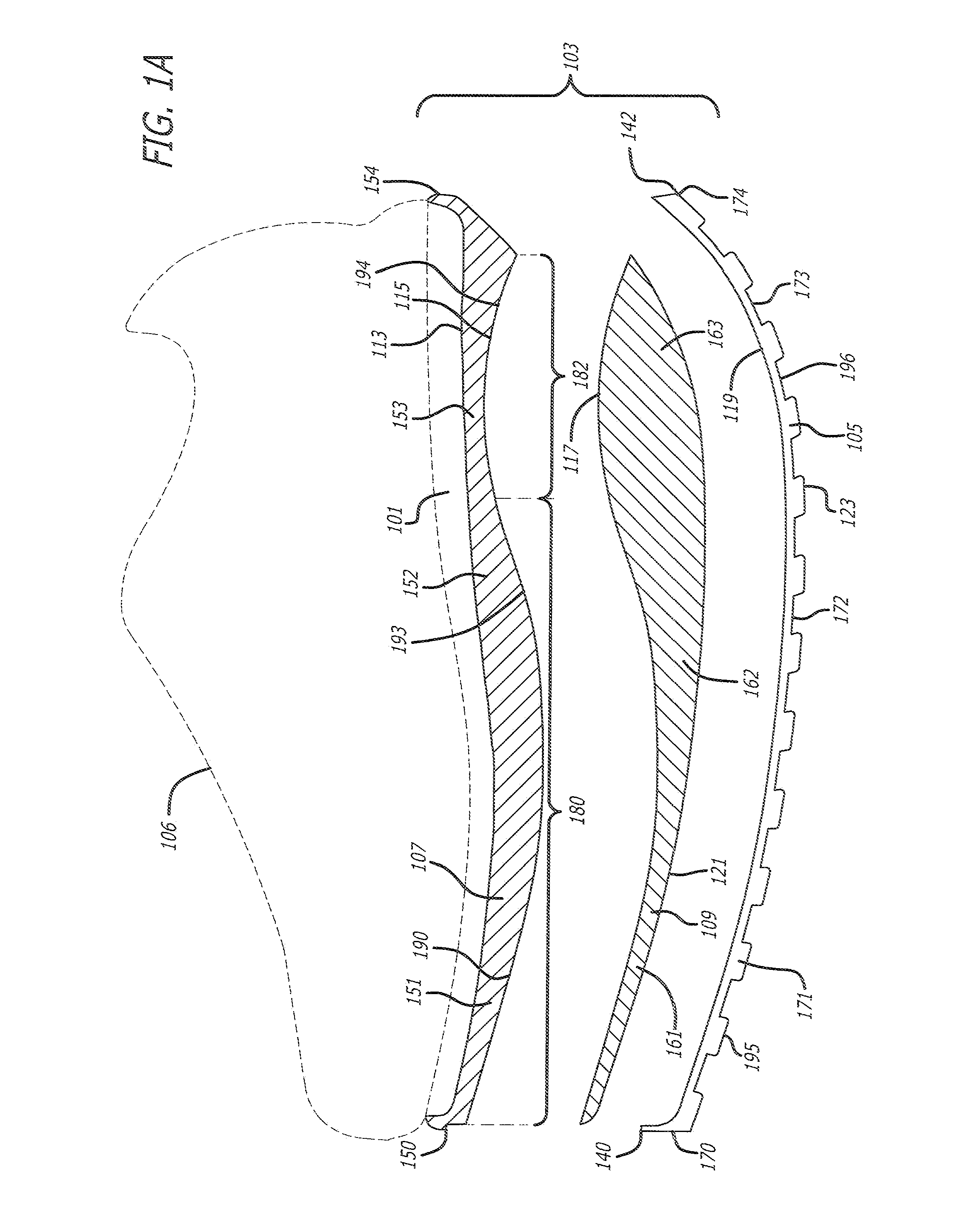[0009]It is an object of the present invention to provide a shoe that mimics the effects, and imparts the fitness benefits, of walking on a sandy beach or on a giving or uneven surface without inducing any pain or discomfort from doing so. The present invention is a shoe comprising an upper, an outsole, and a midsole, each having a
medial side and a lateral side. In a preferred embodiment, the midsole is affixed to the upper and the outsole is affixed to midsole. The upper, midsole, and outsole each has a frontmost point and a rearmost point substantially opposite the frontmost point. When the shoe is being worn by a user, each frontmost point and each rearmost point is oriented with respect to one another such that each frontmost point is closer to the user's toes than each rearmost point while at the same time each rearmost point is closer to the user's
heel than each frontmost point.
[0017]Thus, during walking while wearing a preferred embodiment of the instant invention, when the curved
heel region of the outsole strikes the ground, the
heel region of the lower layer, which is less dense and more easily compressed than the upper layer, deforms to a relatively large degree compared to the upper layer. After each such initial
heel region contact with the ground, the user's heel sinks or moves toward the ground more than it would sink or move in a conventional shoe. This sinking or downward movement is due primarily to deflection of the heel region of the outsole and compression of the heel region of the midsole as they each respond to the
increasing weight being transmitted through the user's heel as the step progresses and the user's heel continues to bear an increasing amount of the user's weight until it reaches a maximum. The
impact is akin to a heel striking a sandy beach or a giving or uneven surface. Then, as the user's weight begins to shift toward the middle region of the shoe, the shoe rolls forward in a smooth motion, without the user having to overcome any abrupt or discrete pivot points. Then the lower layer of the midsole in the middle region and then in the toe region compresses and deforms under the
increasing weight of the user's foot in those regions as the step progresses. This compression and deformation allows the user's foot to sink further toward the ground than would be the case with a conventional shoe. The user then completes the step by pushing off with the
forefoot ball area of the user's foot. This push-off further compresses and deforms the lower layer in the toe region.
[0021]The degree of softness or
hardness felt by the user's foot immediately after the
heel strike is controlled primarily by a longitudinal concavity located in the heel region. This longitudinal concavity is typically relatively large, i.e., it typically has a long length, a large
radius or radii of curvature, and a large amplitude. This relatively large longitudinal concavity allows a relatively thick lower layer to be used in the heel region that can absorb and soften the initial
heel strike of each step. Whereas each longitudinal concavity and each transverse concavity imparts a relatively soft feel to the user's foot while walking, each longitudinal convexity and each transverse convexity imparts a relatively hard feel to the user's foot while walking. This relative
hardness is due to the
decreased thickness of the soft, highly compressible lower layer at each location where a longitudinal or transverse convexity occurs.
[0023]The amount of
muscle use, control and coordination necessary for the user to maintain the user's balance throughout each step increases in direct proportion to each one of the following: (1) increased size, primarily in
wavelength and amplitude, of the longitudinal concavity and / or transverse concavity and (2) increased
compressibility of the lower layer. Increased longitudinal and / or transverse concavity size in the form of greater amplitude corresponds to a thicker lower layer. The
compressibility of the lower layer is a
physical property inherent in the material out of which the lower layer is made. It is a measure of the readiness with which the lower layer compresses under a given load. A high
compressibility means that the lower layer is highly compressible and can be compressed a high amount with relative ease. As the compressibility increases, the user must use more
muscle control and coordination to maintain the user's balance during each step as the weight of the user compresses the lower layer. This compression is accompanied by a downward movement of the user's foot as it compresses the lower layer during each step. This downward compression movement requires balancing by the user to accommodate inherent longitudinal and transverse
instability that accompanies the compression. This inherent longitudinal and transverse
instability is also affected by the thickness of the lower layer. This thickness, as mentioned above, increases as longitudinal and / or transverse concavity size increases. As the thickness of the lower layer increases, the inherent longitudinal and transverse
instability increases. Thus, longitudinal concavities and transverse concavities both contribute to a less stable walking nature of the shoe. The relative opposite effect is achieved with a longitudinal convexity and / or a transverse convexity. Each longitudinal convexity and / or transverse convexity in the upper layer corresponds to a relative thinness in the lower layer. This relative thinness in the lower layer means that the user is not required to engage in as much balancing effort as when the lower layer is thick, primarily because the amount of unstableness in the lower layer is decreased, i.e., the stableness of the lower layer is increased, where each longitudinal convexity and / or transverse convexity occurs in the corresponding upper layer. Thus, longitudinal convexities and transverse convexities contribute to a more stable walking nature of the shoe.
[0024]One of the primary objectives of shoes having midsoles as disclosed herein is to provide fitness benefits to the user by requiring the user, by merely walking, to exert more energy and effort than would otherwise be required when walking while wearing conventional shoes, and to require the user to use, control, and coordinate muscles in ways that such muscles would not be used, controlled or coordinated when walking while wearing conventional shoes. Just as walking on a sandy beach requires more energy and effort than walking on a hard, flat surface, the relatively thick, highly compressible lower layer of the midsole in the area of a longitudinal concavity and / or a transverse concavity requires that a user wearing shoes having such a midsole exert more energy and effort to walk than is required while wearing conventional shoes. The extra thickness and high compressibility of the lower layer in the area of the longitudinal concavity and, if present, the transverse concavity, further allows the shoes to flex more, both transversely and longitudinally, than conventional shoes. In order for the user to maintain the user's balance and a normal
walking gait under such flexure conditions, the user is required to use muscles and to control and coordinate muscles to an extent greater than is required when walking while wearing conventional shoes. The use of such muscles in such a manner further imparts a fitness benefit to the user. These and other fitness benefits of the instant shoe include, among others:
muscle strengthening and toning, better posture, improved
cardiovascular health, less stress on joints, and improved circulation.
 Login to View More
Login to View More  Login to View More
Login to View More 


